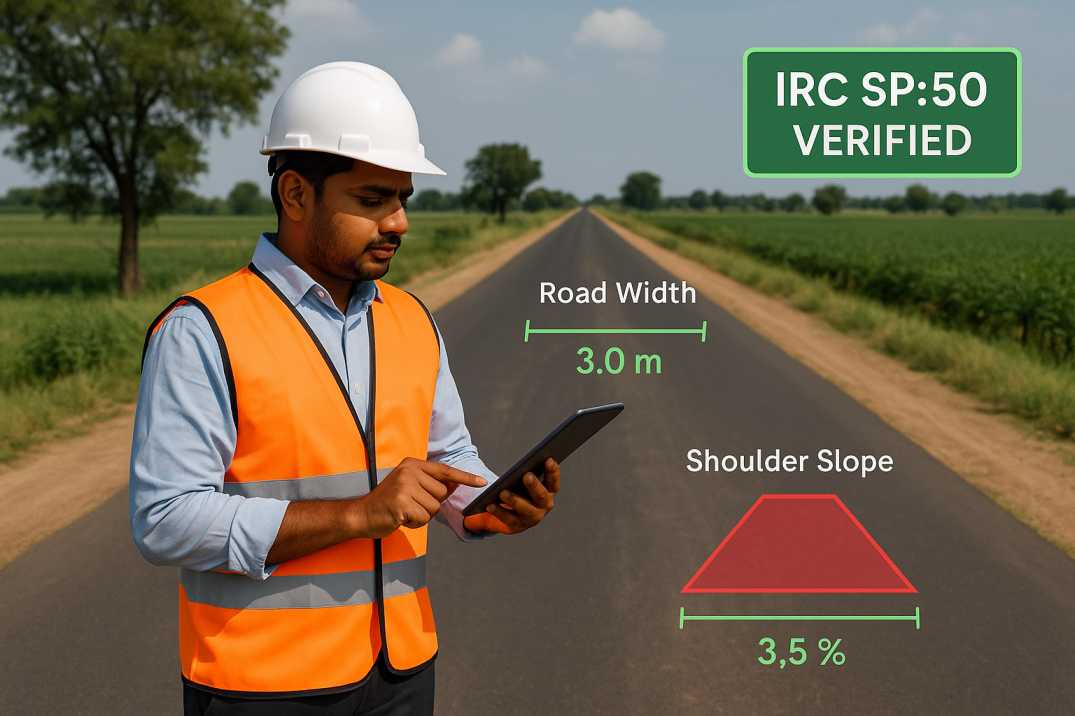Contact Us
RoadVision AI
Private Limited
Office No. 308 & 310, B Block
Ansal Chamber - 1, Bhikaji Cama Place,
Near Engineers India Limited (EIL) Bhawan, New Delhi - 110066
© 2024 | RoadVision AI | All rights reserved
India’s rural road network plays a vital role in last-mile connectivity, economic growth, and infrastructure equity. But ensuring road safety, durability, and design compliance across thousands of kilometers of rural roads is a persistent challenge.
This is where IRC SP:50, the Indian Roads Congress guideline for rural road design, comes in. And now, with the rise of AI-based road asset management, verifying adherence to IRC norms is becoming faster, more scalable, and data-driven.
In this blog, we will explore:

IRC SP:50 is a special publication by the Indian Roads Congress that lays out the design standards for rural roads in India. It covers guidelines for geometric design, pavement structure, drainage, safety measures, and maintenance protocols specifically suited for low-volume roads under schemes like PMGSY and state-funded projects.
Key focus areas include:
By aligning with IRC SP:50, engineers ensure that rural roads are functional, safe, and durable—even under changing loads and weather patterns.
Many rural roads are built under tight budgets with minimal recurring audits. As a result, they often:
Non-compliance leads to faster deterioration, higher maintenance costs, and an increased risk of accidents.
That’s why ensuring compliance with IRC SP:50 is critical—not just for approval and funding, but for public safety and asset longevity.
Traditional compliance and condition assessments involve:
This approach is slow, error-prone, and lacks scalability. Rural areas with difficult terrain or limited access make matters worse.
RoadVision AI uses dashcam video, GPS, and computer vision to automate road inspections, generate reports, and map compliance with IRC SP:50.
Here’s how:
RoadVision AI detects cracks, potholes, shoulder failures, rutting, and more through video analysis. These are key parameters defined in IRC SP:50 distress measurement standards.
Explore more: Pavement Condition Survey
By overlaying collected data with Proforma-1 and 2 formats listed in IRC SP:50, engineers can:
Explore more: Road Safety Audit
Assets such as signage, shoulders, drains, and markings are auto-tagged with coordinates and status, helping engineers track inventory compliance under IRC SP:50.
Explore more: Road Inventory Inspection
Using condition scores and thresholds from IRC SP:50, RoadVision AI suggests:
Explore more: Traffic Survey and Road Usage Analytics
Data from rural road inspections is aggregated and visualized on interactive dashboards, enabling quick action by PWDs, consultants, and PMGSY nodal officers.
Explore insights: Case Studies
IRC SP:50 emphasizes early detection of distress and mandates visual and instrumented condition surveys for maintenance decisions. According to the document:
RoadVision AI brings this to life with:
This aligns with the goal of scientific and data-driven pavement maintenance, as outlined in IRC SP:50.
IRC SP:50 is more than just a set of rural road design rules. It is a blueprint for safer, longer-lasting roads in India’s heartlands. But enforcing it across thousands of kilometers is no small task.
RoadVision AI is transforming infrastructure development and maintenance by harnessing artificial intelligence and computer vision AI to revolutionize road safety and management. By leveraging advanced computer vision artificial intelligence and digital twin technology, the platform enables the early detection of potholes, cracks, and other road surface issues, ensuring timely repairs and better road conditions. With a mission to build smarter, safer, and more sustainable roads, RoadVision AI tackles challenges like traffic congestion and ensures full compliance with IRC Codes. By empowering engineers and stakeholders with data-driven insights, the platform reduces costs, minimizes risks, and enhances the overall transportation experience.
Want to make your rural road audits smarter? Book a demo with us
Q1. What is IRC SP:50?
It is the Indian Roads Congress guideline for rural road design, covering geometric standards, safety norms, and maintenance protocols.
Q2. How does AI help with IRC SP:50 compliance?
AI can automate visual inspections, detect defects, and generate digital reports aligned with IRC SP:50 formats.
Q3. Is IRC SP:50 mandatory for PMGSY roads?
Yes. PMGSY and similar rural road projects must follow IRC SP:50 design and audit norms for funding and approval.